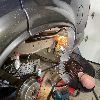nimblemotors
Member
- Joined
- July 17, 2015
- Messages
- 41
- Reaction score
- 3
- Year, Model & Trim Level
- 1997 Explorer 5.0
I've got another explorer, this one a 97 Sport 4wd with 5-speed manual.
Clutch was a problem, it didn't fully release when pressed.
I bleeded it today and flushed out some pretty bad fluid, but no real air bubbles.
It now works OK, but I must press the clutch pedal to the floor, anything less and it doesn't work.
So I'm wondering if this is normal (all mine have been automatics in the past),
or does it indicate a worn slave cylinder/throw out bearing?
Can I fix it by lengthing the clutch master cylinder rod so it fully engages sooner? Can the master cylinder handle that, or does going to the floor already press into the master cylinder all the way?
Appreciate any info.
Clutch was a problem, it didn't fully release when pressed.
I bleeded it today and flushed out some pretty bad fluid, but no real air bubbles.
It now works OK, but I must press the clutch pedal to the floor, anything less and it doesn't work.
So I'm wondering if this is normal (all mine have been automatics in the past),
or does it indicate a worn slave cylinder/throw out bearing?
Can I fix it by lengthing the clutch master cylinder rod so it fully engages sooner? Can the master cylinder handle that, or does going to the floor already press into the master cylinder all the way?
Appreciate any info.










